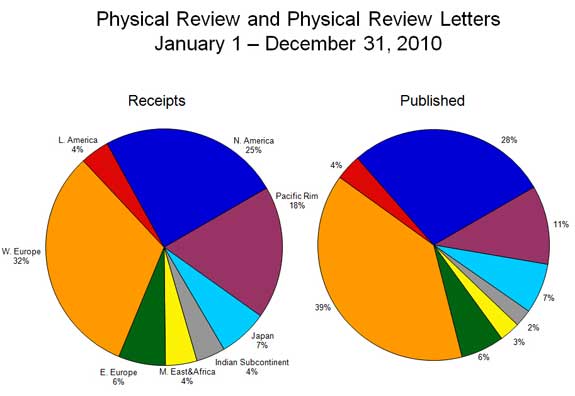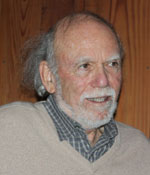Serving our international membership
Barry C Barish
The APS has a very diverse membership. In fact, we have nearly 29% student members and of the non-student membership, 25% reside outside of the U.S. Of course, what we have in common is that we identify ourselves as physicists or with physics, even though some of us are in academia and others in industry; some are beginning their careers and others are near or in retirement; some are born and live in the U.S., while others reside outside the U.S. As the demography of our membership evolves, it is incumbent on us as a society to continually evolve ourselves, such that we best serve our membership.
In this article, I focus specifically on how well we are serving our growing constituency of members who live outside the U.S., and discuss ways in which we might be able to serve this group better. Let me state from the outset that there has not been a barrage of complaints from members or potential members who reside outside the U.S., so my remarks here come from our growing awareness of the globalization of science and the importance that the APS adapt itself to that changing landscape.
Several years ago, APS President Cherry Murray asked CISA to find out how we could better serve our non-U.S. members. One of CISA’s suggestions was to expand the number of non-U.S. representatives on the APS Council. We are very encouraged that we received overwhelming support from the APS membership for this change, even though this increase was done without increasing the total number of APS Councilors. The resulting increase in non-U.S. resident Council members immediately gives a stronger voice to our non US members at the governing and policy making level of the society.
This is a very good step, but we can easily see how far we have to go by simply looking at how well non-U.S. members are represented on APS Committees and Unit leadership? In fact, the answer is, not very well! Excluding CISA and CIFS (our “International” Committees), none of the other 19 APS committees have a single member living outside the U.S. We are not doing much better for Division, Forum and Topical Group Executive Committees, where we just have a small smattering of members who live outside the U.S.
It seems clear that we can and should do better! I believe that by making pro-active efforts, we can make significant progress toward bringing APS members living outside the U.S. onto our committees. The practical problem of travel limitations can be significantly alleviated by our aggressively employing modern telecommunications technology.
The largest and most important functions of the APS are our programs that enable scientific communication for members both through the organization of professional meetings and the publishing of scholarly research papers. In both cases, we need to ask how well we are serving our non-U.S. resident members. Although we have no bias restricting non-U.S. members from participating and presenting papers at our professional meeting, travel considerations present a substantial obstacle. In this case, we can take immediate steps to help mitigate this problem by making the presentations more accessible, again through the use of modern communication tools. In this regard, we are presently working toward a pilot project to post talks on the web, so that they can be accessed around the world, once they are presented at the meetings.
Posting talks on the web is broadly practiced for international physics conferences, making it straight forward for us to adopt an in-use system. The cost of posting talks is not large, especially if the speakers upload their own talks. Of course, we may eventually want to go a step further and consider live video feeds for plenary talks, and that is certainly a future possibility. In my opinion, we will have already gone a long way toward making our meetings more internationally accessible by simply posting the talks. It also seems clear to me that this will add to the impact and importance of our scientific meetings and I doubt very much that it will reduce attendance. (There is no indication that attendance at International Conferences where talks are posted has been adversely affected).

Geographic distribution of submitted and published papers in APS journals
Graph by Barbara Gill, APS Editorial Office
Scientific publishing is our largest and most complicated endeavor and I can hardly discuss all the issues here. But, the APS has done a lot in the publishing area to reflect the growing global nature of the authors and readership of our journals. It is sobering to realize that 73% of our published articles in Physical Review and Physical Review Letters come from outside the U.S. Considering that, I find it truly impressive how well we have done at recognizing these facts and reflecting them in our publishing policies and procedures. For example, the fraction of published vs. submitted papers do not show any dramatic geographic differences, although Asia is a bit lower than the Americas or Europe. We can also conclude that our publication procedures have followed the global diversification of our published articles by noting that the number of U.S. referees has dropped from 1996 to 2006 from 54% to 38%. Also, I might add that our finances also track the demographics, as 70% of our publishing revenues come from outside of the U.S., again reflecting where articles originate.

Evolution of the geographic distribution of APS referees
Graph by Barbara Gill, APS Editorial Office
As we move into the future, we will need to be vigilant and very forward looking, as publishing is in a period of change. Electronic publishing has already become the dominant means of delivery of our journals, enhancing the global reach. We are now entering a new era of open access journals, where there are presently many different approaches being discussed or implemented. Regarding APS publishing, we are working hard to develop the model that will work best for us. Of course, the first criteria is to maintain the high quality of our journals, but also to maintain fully international policies and develop a sustainable business model.
I should at least mention that there are other very important international areas that concern the APS. For example, the globalization of science research and the emergence of large international collaborations and building and operating international facilities present many opportunities, as well as new problems. The APS, as a voice of the American physics community, can help communicate the value of these international research opportunities to our government, and to also work internationally to assure that these facilities are implemented such that they are available to physicists worldwide and as free of politics as possible.
Finally, I would like to close by recognizing one other international area where the APS is active and can make a difference. Emerging countries are rapidly developing an increasingly educated scientific community, but typically have little tradition or local organizations that provide the type of home for their professional physicists that are provided by the APS. We are investigating possible partnerships in such countries, in order to both build relationships and help them develop their own equivalents of the APS.
Although I have concentrated on areas of internationalizing the APS activities in this article, I should emphasize that we fully intend to remain a society for American physicists, but having increased benefits, policies and representation from our non-U.S. members.
Most of the issues I have raised here do not represent one year problems and I don’t want to leave you with the impression that I want to drastically change and internationalize the APS. Instead, I see the APS making stepwise changes to better include our international membership, while preserving the functions that the APS plays for American physicists and physics. Over a period of several years, I believe we can both maintain these core responsibilities, while evolving ourselves to better serve our growing international constituency
I have presented a number of my ideas and plans for strengthening the international programs of the APS in this article, but at the same time, I am interested in hearing your reactions and ideas.
Barry Barish is the Linde Professor of Physics Emeritus at Caltech and APS President.

Disclaimer—The articles and opinion pieces found in this issue of the APS Forum on International Physics Newsletter are not peer refereed and represent solely the views of the authors and not necessarily the views of the APS.
